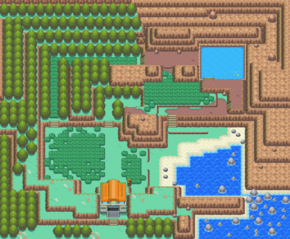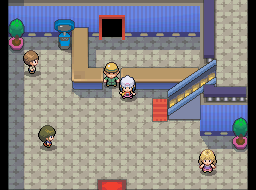Pal Park

|
This article is incomplete. Please feel free to edit this article to add missing information and complete it. Reason: Missing complete interior lobby layout image |
| |||||
| |||||
| Map description: | This used to be the location of the Safari Zone, but is now the Pal Park.HGSS | ||||
|---|---|---|---|---|---|
| Location: | Route 221, Fuchsia City | ||||
| Region: | Sinnoh and Kanto | ||||
| Generations: | IV | ||||
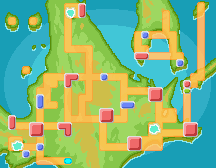 Location of Pal Park in Sinnoh. | |||||
| Pokémon world locations | |||||
Pal Park (Japanese: パルパーク Pal Park) is a special Pokémon preserve present in the five Generation IV core series games, located at the east end of Route 221 in Sinnoh and in Fuchsia City in place of the Safari Zone in Kanto. In Kanto, after the warden closed the Safari Zone, his son opened Pal Park in its place.
According to Professor Oak, Pal Park attracts Pokémon from other regions.
In Pokémon Brilliant Diamond and Shining Pearl, Pal Park is replaced with Ramanas Park.
Accessing Pal Park
In Diamond, Pearl, and Platinum, Pal Park does not open until the player has obtained the National Pokédex. Once they have it, Professor Oak will meet the player on Route 221 and invite the player inside the Pal Park building, where he briefly explains how the park works. Once the player has access to Pal Park, the "Migrate from <game>" option will appear on the main menu screen when the game is loaded, provided a Generation III game is in the Nintendo DS's second slot.
In Pokémon HeartGold and SoulSilver, since Pal Park is located in Kanto, which the player must have the National Pokédex to visit properly, the player must have the National Pokédex to access Pal Park. After the player visits Fuchsia City for the first time, the migrate option will appear on the menu screen whenever the player has a GBA game in the Nintendo DS's GBA slot, regardless of whether they have visited Pal Park.
Migration
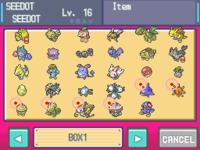
Pal Park allows the player to permanently transfer Pokémon from a Generation III core series game to a Generation IV core series game. Once a Pokémon is migrated to a Generation IV game, it can never return to a Generation III game.
First, Pokémon must be migrated from the Generation III game. Once the player has visited Pal Park in the Generation IV game, if a Generation III core series Game Pak is inserted in the GBA slot of the same Nintendo DS or Nintendo DS Lite system as the Generation IV game, an option will appear on the Generation IV game's main menu labelled "Migrate from <game>". If the player has migrated Pokémon that have not yet been caught, they will not be able to use this option.
When selecting the "Migrate" option, the player is presented with a stripped-down view of the Generation III game's PC on the Nintendo DS's touch screen. On the transfer screen, the player can only view the Pokémon's minisprite, species, nickname, level, markings, and held item. Pokémon that know a move that is an HM in the origin game (called "hidden moves" by the game) cannot be migrated. After selecting exactly 6 Pokémon, the game will confirm with the player that they want to send those 6 Pokémon.
In Pokémon Diamond, Pearl, and Platinum, it is only possible to migrate 6 Pokémon to that game from a specific Generation III save file once per 24 hour period; in Pokémon HeartGold and SoulSilver, this restriction was lifted, allowing an unlimited number of migrations from a single game in a 24-hour period.
Pokémon can only be migrated if the Generation III game and Generation IV game are the same language, unless the Generation IV game is Korean, in which case any language Generation III game can be used (due to the Generation III games not being released in Korean). However, it is possible to trade between languages in Generation III, so it is possible to migrate, for example, a Pokémon originally met in a Japanese game from a Spanish Generation III game to a Spanish Generation IV game.
The games will permanently treat the Pokémon's current name as a nickname if it does not match the expected name for that language. As a result, using Pal Park in a Korean Generation IV game will always cause the transferred Pokémon to be treated as having a nickname, because there are no Korean versions of the Generation III core series games, and the Korean Generation IV games support nicknames in scripts other than Hangul.
Manipulation
The restrictions in Pokémon Diamond, Pearl, and Platinum to prevent the player from transferring Pokémon from each Generation III game more than once per day can be subverted in certain ways.
If, once a Catching Show has been completed, the player turns off the game system and changes the date on the Nintendo DS to the next day, then inserts a second Generation III game, they will be instructed to reset the time on the DS. This will prevent migration from that second game, but allow the original game—that has already had six Pokémon transferred—to send Pokémon into the Generation IV game.
Alternatively, the player can restart the save file on the Generation III game. These restrictions are only per save file, so restarting the Generation III game will allow Pokémon to be migrated from that Game Pak multiple times in the same day.
Despite these workarounds, no further migrations can be made until all six Pokémon transferred have been caught, and changing the Nintendo DS clock or playing the game on another Nintendo DS system will delay Pal Park migration, as well as other time-related events, for 24 hours.
Catching Show
After the Pokémon have migrated to the Generation IV game, the Generation III game is no longer required. The migrated Pokémon can be obtained in the Generation IV game by catching all six in Pal Park's Catching Show.
During the Catching Show, the player has to encounter and catch all six migrated Pokémon. At the start of the Catching Show, the player is given six Park Balls, a special type of Poké Ball that can only be used during the Catching Show and which never fails. Other items cannot be used during the Catching Show, not even registered key items such as the Bicycle.
The park is divided into five distinct areas, with migrated Pokémon appearing in one of the five based on their species. Two of the areas are water areas, and require Surf to encounter Pokémon. During an encounter with a migrated Pokémon, Abilities that activate upon entering battle will not activate, and there are only two commands: Throw Ball and Run. Even if the player runs, they can still encounter the Pokémon again at a later time to catch it (in case they want to catch it in a different order for better Type Points). The player can leave the park at any time, either by walking back through the front entrance or by selecting the Retire option from the menu, but if they do then the Catching Show is annulled without being scored, and they must re-capture all migrated Pokémon on a subsequent visit.
Each Pokémon has a rarity value that is inversely related to its catching score (see Scoring below):
| Score | 100 | 90 | 80 | 70 | 50 | 30 |
|---|---|---|---|---|---|---|
| Rarity | 1 | 3 | 10 | 20 | 30 | 50 |
On any step in tall grass or water in which the player could potentially have an encounter, the game determines each migrated Pokémon that has yet to be caught and that can be found in the current area, then draws from a random sampling in which each of those Pokémon is weighted equal to its rarity value, and a fixed weight of 20 is given to the possibility of not having an encounter. For example, if the player is in the Field and still has Venusaur (score 90, rarity 3), Charizard (score 90, rarity 3), and Pichu (score 80, rarity 10) left to be caught, the total sample size will be 3 + 3 + 10 + 20 = 36, meaning the step will result in no encounter 20/36 of the time (55.6%), an encounter with Pichu 10/36 of the time (27.8%), or an encounter with Venusaur or Charizard 3/36 of the time each (8.3%). Regardless of the outcome, the player is then required to take a random number of steps between 5 and 14 before the next step that checks for a possible random encounter again.
After the player catches all six Pokémon, the player can choose either to place all six caught Pokémon in their boxes, or to keep the Pokémon in the park for a future Catching Show. The player does not gain ownership of any Pokémon caught in the Catching Show until they choose to place the Pokémon in their boxes.
Scoring
In addition to transferring Pokémon from Generation III, Pal Park also has a score system that will offer rewards depending on the player's score. When Pal Park is first visited, a default high score of 2000 will be set by the player's rival (either Barry in the Sinnoh games or Silver in the Johto games, using the name the player chose for them). The score will be given at the end of the Catching Show by the Park Ranger, and is divided into three components:
- Catching Points
- A base value for each Pokémon caught. This score is included for each species in the List of Pokémon by Pal Park location page. Pokémon with higher point values also have higher rarity, and usually take longer to appear in grass or water. The maximum possible score in this component is 600, if the player has transferred six Mythical Pokémon (which requires at least two duplicates among them). If the player attempts multiple Catching Shows with the same set of six Pokémon, Catching Points will always be the same each time regardless of performance.
- Time Points
- A measure of how quickly the player tracks all six Pokémon down. This score starts from 2000 at the beginning of the show, and 2 points are subtracted every second until it reaches 0 points after 16 minutes 40 seconds. If the show takes longer than that, time points will remain 0 rather than becoming negative. As each encounter and capture animation takes some amount of time, getting the full 2000 points is not possible.
- Type Points
- A measure of type diversity. For each Pokémon caught after the first, there is a 200-point bonus if it doesn't share any types with the Pokémon caught immediately before it (so catching Pokémon in a different order may result in a different score in this component). There is also a 50-point bonus for each distinct type represented among the six Pokémon collectively, which remains the same regardless of what order they were caught in. The maximum possible score in this component is 1600, which requires that the player migrated six dual-type Pokémon that have no type overlap among them.
Rewards
The Park Ranger always gives the player a Berry as a reward after a completed show; the higher the score, the rarer the Berry.
Modifications to transported Pokémon
Despite the player in the Generation IV game catching the Pokémon again, its OT, ID number, and Poké Ball remain the same. Migrated Pokémon retain their held items. Their friendship is reset to 70.
Many Pokémon obtained in Generation III gained an Ability in Generation IV. Due to Ability being dependent on personality value in the Generation III and IV games, this means that some migrated Pokémon have an Ability that does not match their personality value (since the Ability is not changed upon migration). However, because Abilities are recalculated upon evolution in Generation IV and V, if that Pokémon evolves in games of these generations its Ability will change to match its personality value.
While non-English and non-Japanese characters cannot normally be used in the Generation III games, they do occur in some in-game trades and preset player names. If a Pokémon has a nickname or original Trainer that has one of these characters, it will be turned into a kana character in the Western Generation IV games due to encoding issues.
Pal Park only reads the data of the game the Pokémon was originally generated in, rather than its in-game met location, setting the met location to simply "Pal Park" rather than retaining the Gen III met location data. This sets any Pokémon created in FireRed or LeafGreen to Kanto; Ruby, Sapphire, or Emerald to Hoenn (even if it was caught on Navel Rock or Birth Island, which are located in Kanto); and Colosseum or XD to "distant land". (Pokémon obtained from Wonder Cards are treated as being created in the game they were received in.) A Pokémon whose Egg is created in a game based in one region and traded to another region before it was hatched will display the name of the region it was generated in, rather than the one it was hatched in; this means that a Pokémon generated in Emerald but hatched in FireRed will have the OT and ID of the FireRed player but list that it was met in Hoenn.
In addition, the level obtained at is changed to the level arrived at. Due to the lack of a calendar in the Generation III games, the date obtained becomes the date it was caught in the Catching Show.
If a Pokémon was met in a fateful encounter, this information is retained upon transfer.
- Pokémon originating from games or events released prior to Pokémon FireRed and LeafGreen that display "obtained in a fateful encounter" or "fateful encounter" in their summary do not retain that information upon transfer, as the flag did not exist in those games. They do not gain this flag through trade or transfer to games where the flag does exist, nor is the "met in a fateful encounter" met location data retained when sent to Pal Park.
Geography
Lobby
Pal Park is a large area consisting of a large park and a small entry building. Entering the building will take the player into the lobby, where they can accept to take part in the Daily Catching Show by talking to the Park Ranger. There are two floors in the lobby. The first is where registration for the show takes place. One woman on the left side of the building will tell the player their highest score achieved in the Catching Show, another will give the player two Pokétch apps, the Kitchen Timer and Color Changer by showing her a Snorlax and a Kecleon respectively. The second floor is accessible using the stairs on the right. Many people come up here to see all of the shows, as there are glass windows from which the entire park can be seen. In total, there are seven people within the lobby.
In HeartGold and SoulSilver, Pal Park is located in Fuchsia City, replacing the Safari Zone from Generations I and III. It holds almost exactly the same function as Sinnoh's Pal Park. It is available as soon as the player arrives in Fuchsia City, as the player already has the National Pokédex by then.
Park
- Main article: List of Pokémon by Pal Park location
Pal Park itself is a huge park, with different terrains to suit all sorts of different Pokémon. Upon entering, the player will begin in the field area of Pal Park. This contains a large open space with large patches of tall grass, inhabited by field Pokémon. There are two patches of grass within the area, a small patch on the east, and a larger patch on the west. There are 123 Pokémon that can appear in this area. There are three different paths the player can take in order to get to another area of the park; the northwestern stairway will take the player to the forest area, the northeastern stairway will take the player through a pathway to the mountain area, and traveling east will take the player to the sea area by jumping off a ledge.
By following the path up the far northwestern side of the park, the player will reach the forest area of Pal Park, where forest-dwelling Pokémon live. There are 74 Pokémon that can appear in this area. It is a long, narrow strip of pathway following up the far western side of the park, then it takes a right turn up in the corner of the park, and travels east until the player reaches the pond area. The path is a long, narrow, dark pathway covered by tall trees, with the ground covered all the way by tall grass. The only other way to get to and from the forest area is by traveling through the pond area.
When the player reaches the pond area via the forest area, the player must travel a short distance east to reach the pond, a pool of water, able to be surfed across, where all the wild Pokémon inhabit. There are 37 Pokémon that can appear in this area. If the player travels south while getting there, they will find a ledge going down into the mountain area. Once entering the square pond to find Pokémon, they can go south to reach dry land, where they can also climb up and down stairs on the steep mountainside to reach the sea area. Alternatively, the player can enter from the sea area by traveling north through part of the mountain area to reach the southern part of the waterside, where the player can surf across the light water to the other side. There is no other way of getting to the pond in the northeastern corner.
The mountain area is located in the middle of a mountainside, in the center of Pal Park. It can be accessed by jumping a ledge in the pond area just north of there, or going through a little forest pathway from the field area. The mountain area has a small patch of grass, where the player can find wild Pokémon. There are 105 Pokémon that can appear in this area. Most of this area is covered with grass, while only a small part of it isn't. There is also a ledge the player can jump down to reach the sea area. This is the only way to leave the area apart from turning back to the field area.
The final area in the park, known as the sea area, is found in the southeastern corner of the park. It can be accessed by going east from the field area, or south from the mountain area, by jumping down the ledge and going down the mountainside. The sea area makes up a large section of the park, with a large area of sea coming in from the west. When the player enters from the mountain or pond area, there is a large ledge to a sandy beach where the sea meets the land. The area also has rocky terrain, with many rocks on the beach and in the water blocking the way, so that the player cannot travel any further east past the mountain side. By surfing across the deep blue water, the player can encounter many different types of wild sea Pokémon. In total, there are 47 Pokémon that can appear in this area. If the player goes west past another set of ledges, they will end up back on the eastern side of the field area where they began, making a big loop.
Although it is a West Sinnoh location in Diamond, Pearl, and Platinum, it uses East Sinnoh trees. Similarly, it is a Kanto location in HeartGold and SoulSilver but it uses Johto trees and rocks.
Items
| Item | Location | Games | |
|---|---|---|---|
| Trainer Counter | Given by Professor Oak upon entering Pal Park | D P Pt | |
| Park Ball ×6 | Given by the Park Ranger to capture the six Pokémon in the Catching Show; cannot be kept afterwards | D P Pt HG SS | |
| Kitchen Timer | Given by a woman in the lobby after showing her a Snorlax | D P Pt | |
| Color Changer | Given by a woman in the lobby after showing her a Kecleon | D P Pt | |
Game Boy Advance game-based gifts
There is a girl in the Pal Park lobby who will give the player a gift based on the game currently in the Game Boy Advance slot of the Nintendo DS system. Like the dongle method, the language of the game is ignored; this means that she can give the player the gift even if that game could not migrate Pokémon to Pal Park.
| Item | Location | Games | |
|---|---|---|---|
| Crown | Given by a girl in the lobby if Pokémon FireRed is in the GBA slot | D P Pt HG SS | |
| Tiara | Given by a girl in the lobby if Pokémon LeafGreen is in the GBA slot | D P Pt HG SS | |
| Underground | Given by a girl in the lobby if Pokémon Ruby is in the GBA slot | D P Pt HG SS | |
| Seafloor | Given by a girl in the lobby if Pokémon Sapphire is in the GBA slot | D P Pt HG SS | |
| Sky | Given by a girl in the lobby if Pokémon Emerald is in the GBA slot | D P Pt HG SS | |
Appearance
Outside
| Diamond | Pearl | Platinum | HeartGold | SoulSilver |
|---|---|---|---|---|

|

|

| ||
Park
| Diamond | Pearl | Platinum | HeartGold | SoulSilver |
|---|---|---|---|---|
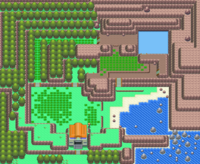
|

|

| ||
Music
The Pal Park shares its background music with the resident Safari Zones in the games it appears in, using that of Johto's in HeartGold and SoulSilver, and using that of the Great Marsh in Diamond, Pearl, and Platinum. This is somewhat fitting considering it replaces the Kanto Safari Zone in HeartGold and SoulSilver, though the Kanto Safari Zone theme is the same as the trading and evolution theme.
Trivia
- In the internal data of the Generation V games, the theme of the Poké Transfer Lab, which is titled the same in the soundtrack release of Pokémon Black and White, is called SEQ_BGM_PALPARK. This is a reference to it being the generation's equivalent to the Pal Park of the Generation IV games.
- Prior to the release of Pokémon Platinum, Pal Park was the only way to obtain Tangela (and thus its Generation IV evolution Tangrowth), Tropius, the Legendary birds, and the Legendary titans in the Generation IV games. Prior to the release of Pokémon HeartGold and SoulSilver, Pal Park was the only way to obtain starter Pokémon introduced before Generation IV, Mewtwo, Ho-Oh and Lugia, the super-ancient Pokémon, and the eon duo.
- Prior to the 2007 PalCity Mew distribution, the 2010 Japanese Movie Celebi distribution, the 2007 Tanabata Jirachi distribution, and the 2007 Japanese 10th Movie Deoxys distribution, Pal Park was the only way to obtain Mew, Celebi, Jirachi and Deoxys in the Generation IV games, respectively.
- Some Pokémon, such as Regice, which are only obtainable via an event in Generation IV, can be obtained without one in Generation III.
- Some items can only be obtained in Generation IV through Pal Park.
Name origin
The English and Japanese names are based on the word "pal", an affectionate term for a friend. Other language versions use a similar naming style, although the German- and French-language versions are less colloquial and translate to Park of (the) Friends.
In other languages
| |||||||||||||||||||||||||||||||||
See also
| Sinnoh | ||||||||
|---|---|---|---|---|---|---|---|---|
|
| ||||||||
|
| Kanto | ||||||||
|---|---|---|---|---|---|---|---|---|
|
| ||||||||
|

|
This article is part of Project Locations, a Bulbapedia project that aims to write comprehensive articles on every location in the Pokémon world. |
